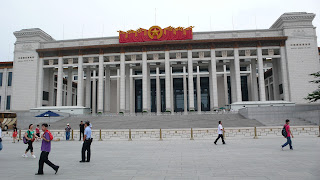Day 13: Beijing, June 29, 2012
6:30 am: Getting up
It’s not Friday the 13th of June but the last and 13th day
of our field trip. Looking out of the window, what we will see is not amusing,
it’s dark and... Sure our day starts... you can guess with rain! By the way,
yes the sky is not blue like always here in China. Some guys told us it’s
because of the smog, others whispered it's a mixture of rain, dust, traffic jam
and of course 1.2 billion Chinese people crossing the various streets of Beijing
to get to their job, to find their space, fill out the gap. Anyway it doesn't
matter, the good mood from everyone experiencing another day of great inputs
and diverse daily program will clear up the misty, foggy sky. So we jump out of
the bed.
07:00 am: Time for breakfast
Same procedure as always we rushed down the street took an
oversized water melon, and a big piece of dry bread, we dream it was bread with
Nutella, western style. Not to forget the Swiss knife cracking up the melon and
putting down the Nutella mmmhhh....
07:32 am: Gonna be time for the first group meeting
07:45 am: Tube pressure
 |
A bit fuzzy, but nevertheless this shot illustrates the masses that are trying to get on the Beijing subway
(Photo: Heike Mayer) |
We went down to the alley from the hotel. Seconds later we
don't know how it comes... sure, pressing down the tube, going down in the
flood of men, pushing us into the tiny, sticky tube and go on... 2-1-10 we are
there. Tube, but no horns honking around in the streets, crazy taxi drivers
speeding up the streets of Beijing in an awesome manner of driving, we couldn’t
copy...!
09:15 am: The OSEC
The OSEC is located near the Swiss embassy. There we got a
really good introduction about the Swiss-Chinese business relationships for small
and medium-sized enterprises who want to enter the Chinese market. Basically
the OSEC is supporting small and medium-sized enterprises to get a foothold in
Chinese markets by examining possibilities and leveling the cultural
differences between Swiss and Chinese business people.
However, most interesting have been the "geraniums",
lovely assorted flower decorations on plates. It was great, they have giving us
a feeling of being home and experience true Swiss patriotism.
00.10 pm: Coffee time
Sit down in the coffee shop was less the problem than to get
our food ordered. Actually the guy told us "just wait one minute" ...
later we realized it has been about 45 minutes... but the result was awesome -
we get a really good 45 minute well done burger...
So enough telling about burgers, we also delivered a short
student input presentation about a comparison between innovative and non-innovative
enterprises in the Zhongguancun industrial estate park.
03:00 pm: Haidian Science Park
 |
| Haidian Science Park is home to numerous universities (Photo: Heike Mayer) |
 |
| View of Haidian Science Park (Photo: Heike Mayer) |
As we reached the industrial park we got a brief
introduction about technology-related research and development which takes
place in this park. In short, it was dealing with industries and companies
coming together, joining to set new standards which later can be spread around
in the whole world. This because of the huge market of China.
04:00 pm: Taxi cruise back to the hostel
So we are sitting in the taxi, yes a little bit of honking, which
we do need after this long time in China to be satisfied and happy... Dreaming
through the city, cars passing by, sure including the obligatory traffic jam we
are happy to look forward to the great Korean barbecue dinner and the closing session
of our field trip this evening.
 |
| Korean BBQ (Photo: Heike Mayer) |
 |
| Celebrating with Daniel, our great tour guide (Photo: Heike Mayer) |
 |
| Gambei! |
It is our last day together and our last day of
a great field trip in China, which will leave awesome memories in all of our
minds.
Nicolas Dränert, Mathilde Hofer


















































